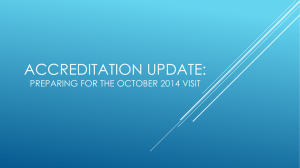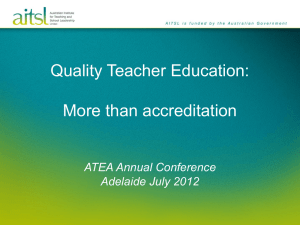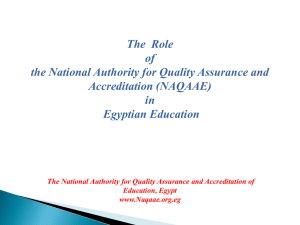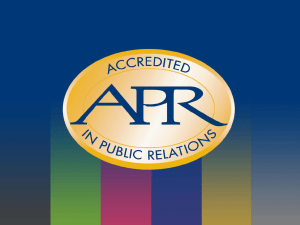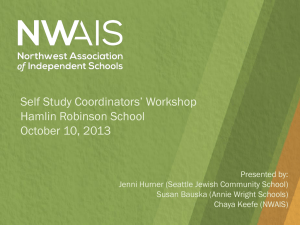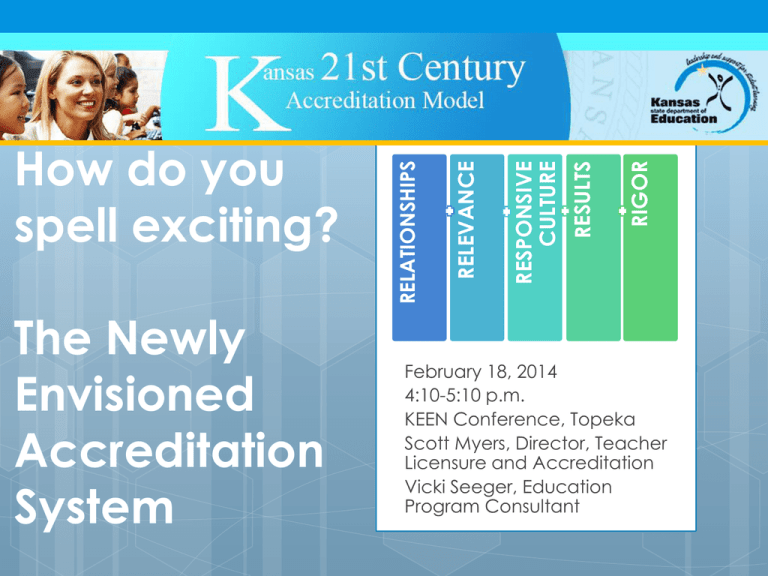
The Newly
Envisioned
Accreditation
System
RIGOR
RESULTS
RESPONSIVE
CULTURE
RELEVANCE
RELATIONSHIPS
How do you
spell exciting?
February 18, 2014
4:10-5:10 p.m.
KEEN Conference, Topeka
Scott Myers, Director, Teacher
Licensure and Accreditation
Vicki Seeger, Education
Program Consultant
Objectives
Overview
Compare
QPA to the proposed
accreditation model
Learn about the district accreditation
cycle
Understand how teachers are part of the
accreditation team
Experience using the Relationships and
Relevance rubrics as a needs assessment
College and Career Ready
As we think about accreditation,
we need to keep in mind the
definition of Kansas College and
Career Ready:
College and Career Ready means an individual has the
academic preparation, cognitive preparation, technical skills,
and employability skills to be successful in postsecondary
education, in the attainment of an industry recognized
certification or in the workforce, without the need for
remediation.
Accreditation
Major Differences
The new district accreditation model will be
different in several ways:
The new model focuses on districts rather than
schools
We are moving away from a punitive
accreditation system focused primarily on
achievement at the school level
The model is likely to be a four-year
accreditation process with an interim year to
prepare districts for the process of conducting
needs assessments and examining change that
the district would like to see occur
Districts and KSDE will be able to conduct
meaningful research as a result of the new
model
Accreditation
District Accreditation Cycle:
Interim Year
Foundational
Elements:
•
•
•
•
•
•
•
•
•
Licensed Educators
KAR 91-31-34
State Law
Local Graduation Policies
School Improvement Plan
Secondary Programs and
Services
External Assistance Team
Curricula
Programs and Services
Performance
Elements:
•
•
•
•
Yes on Achievement,
Growth, or Gap
95% of students are
tested
Graduation Rate
Attendance Rate
Accreditation
District Accreditation Cycle:
Year One
•
5Rs Rubrics are completed by the districts
•
Evidence submitted to repository to support
ratings on the 5Rs rubrics completed by the
district
•
•
•
Documents or reports currently submitted to KSDE
Evidence the district already has in place
New evidence artifacts will be minimal
•
KSDE and External Team Review
•
Set two change goals from the sub-R categories
based on the results of the 5Rs rubrics
Accreditation
District Accreditation Cycle:
Year Two
Implementation of best
practices/strategies for Change
Goal #1
Implementation of best
practices/strategies for Change
Goal #2
Data collection on goals #1 and #2
Accreditation
District Accreditation Cycle:
Year Three
Initial Data Analysis of
Change Goals #1 and
#2
Continued
Implementation of
Change Goals
Adjustment to best
practices/strategies if
warranted
Continued data
collection
Continued analysis of
results
Accreditation
District Accreditation Model:
Year Four
Final year of
implementation
of change goals
and best
practices/
strategies
Final data
analysis in Spring
RIGOR
RESULTS
RESPONSIVE
CULTURE
RELEVANCE
RELATIONSHIPS
Accreditation
Defining the 5 Rs through the
Rubrics
Accreditation
Defining the 5 Rs – First R
Relationships
Staff
Students
Families
Community
Relationships—a state of interconnectedness among people,
curricula, programs, projects, and communities—are critical in
establishing connections that result in high performing learning
environments (KSDE, 2010, p. 40).”
Accreditation
Defining the 5 Rs – Second R
Relevance
Curriculum
Instruction
Student
Engagement
Technology
“Relevance—the power and ability of specific information to meet the
needs of its user—strengthens learner motivation and allows learning to
become more engaging, empowering, connected, applicable to the
real-world, and socially significant (KSDE, 2010, p. 42).”
Accreditation
Defining the 5 Rs – Third R
Responsive Culture
Leadership
District
Climate
Early
Nutrition &
Childhood Wellness
“A responsive culture—one that readily reacts to suggestions, influences,
appeals, efforts, or opportunities—empowers all stakeholders to become
respectful of, responsible for, and involved in learning, the learning
process, and the learning community (KSDE,2010, p. 48).”
Accreditation
Defining the 5 Rs – Fourth R
Rigor
Career and
Professional
Technical
Learning
Education
Resources
Data
Rigor—a relentless pursuit of that which challenges and provides
opportunity to demonstrate growth and learning—is essential is
addressing the needs of our rapidly expanding society and world
(KSDE, 2010, p. 44).”
Accreditation
Defining the 5 Rs – Fifth R
Results
Growth in
Achievement
Student
Data
Achievement
Reduced
Reduction in
Gaps in
NonStudent
proficient
Achievement
Other
Measures
“Focusing on results—witnessable evidence of growth and learning—allows curriculum
and instruction to be delivered in a timely fashion based on the needs and desires of the
individual learner. Informative and summative assessment, coupled with research-based
effective teaching practices, can provide the data and information necessary to fuel
teaching and empower learning (KSDE, 2010, p. 46).”
Accreditation
Using the Relationships Rubric
as a Needs Assessment
•
How does the criteria for each of the sub Rs
carry out the intent of the definition for
Kansas College and Career Ready?
•
What parts of the rubric are a strength for
your district?
•
What parts of the rubric might need to be
strengthened for your district?
Accreditation
What to do
First,
learn how another district completed
the rubric
Use the Relationships Rubric and conduct
a needs assessment for your district
Mark where you believe your district
would fall on the rubric while also
recording comments
The comments assist you in developing
rationale for your rating on the rubric
10:45-11:15 a.m.
Concordia: Relationships
Communities
Criteria
Community:
Communication about
academics
No Evidence
Modeling
Comments
Provides resources to the
community concerning the
Kansas College and Career
Ready Standards, state and
local assessments, and district
curriculum alignment.
Implementing
Provides training and resources
to the community concerning
the Kansas College and Career
Ready Standards, state and
local assessments, and district
curriculum alignment.
Transitioning
Documents relationships among
the Kansas College and Career
Ready Standards, state and
local assessments, district
curriculum alignment,
volunteerism, and other
opportunities in the community.
Five different community
partners have been developed
including one with Lincoln, KS
where industry has placed new
state-of-the-art welding
equipment at the high school for
students to use during their
coursework on welding.
Plans for a variety of means to
gauge the community's needs
such as open dialogues,
meetings, community
gatherings, questions, and
surveys in order to assess
progress and performance.
Provides a variety of means to
gauge the community's needs,
such as open dialogues,
meetings, community
gatherings, questionnaires, and
surveys in order to assess
progress and performance.
Demonstrates an organized
structure to communicate with
the community and to ensure
their involvement is in place.
The community does not always
reciprocate the conversation
and discussions.
Identifies and involves
community members in the
school improvement planning
process.
Identifies and involves
community members in the
school improvement and longrange planning processes.
Documents the role of
community partnerships to share
resources and support students'
interests and aptitudes.
Identifies and involves
community members in the
school improvement planning
and long-range processes.
Integrates community resources
into improvement plans.
Documents the role of
community partnerships to share
resources and support students'
interests and aptitudes.
Resources have been
developed with industries
(welding), Cloud County
Community College instructors
(nutrition and nursing), and a
local chef. The district wants to
develop pathways for CNAs and
for culinary arts.
Requires a peer mentoring
process for all teachers.
Requires a peer mentoring
process for all teachers including
documentation of peer
observations at least once per
year.
Requires ongoing peer
mentoring process for all
teachers including
documentation of peer
observations at least twice per
year. Provides professional
development for mentoring
processes.
Unsure about a rating for this
particular criteria. The district
does not require all teachers to
participate; a formal process in
not in place.
Community: Evaluation
Community: A resource
Staff
Support for classroom
educators (3+ years)
Accreditation
Using the Relevance Rubric
as a Needs Assessment
•
How does the criteria for each of the sub Rs
carry out the intent of the definition for Kansas
College and Career Ready?
•
How would your district fare for each subR?
•
Where will your district need the most
professional learning?
11:15-11:45 a.m.
Accreditation
Achieving District
Accreditation
•
Accredited: Carrying out the implementation of
strategies for change with fidelity, collecting and
analyzing the data, reflecting and reporting on the
results, and identifying next steps
•
Accredited with Support: Failing to complete all
steps within the four‐year cycle
•
•
results in regular conferencing with KSDE staff, quarterly
reporting of progress in the next accreditation cycle, and
annual completion of the 5 Rs rubrics.
Not Accredited: Failing to complete all steps and
reporting information for multiple years despite
support from KSDE
Accreditation
Reporting Districts
Relationships
Relevance
Curriculum
Staff
Instruction
Students
Families
Student
Engagement
Community
Technology
Responsive Culture
Leadership
Early Childhood
District Climate
Nutrition &
Wellness
Rigor
CTE
Professional
Learning
Resources
Data
Accreditation
The District
Accreditation Team
What
will the composition be for your
District Accreditation Team?
How can educators, like yourselves,
advocate to be a part of the team?
How can trust issues within a district be
addressed honestly and openly?
What ideas do you have for involving lots
of district staff and community
stakeholders in the process?
Accreditation
Setting District Goals
Families
The district chooses to set a goal targeting
relationships with families and engagement
at the building level.
District Climate
The district chooses to set a goal to survey
all stakeholders in the community to assess
perceived culture and climate.
2:30-2:45 p.m.
Questions ??
Contacts:
Scott Myers,
Director
Teacher Licensure and Accreditation
smyers@ksde.org
Vicki Seeger,
Education Program Consultant
Teacher Licensure and Accreditation
vseeger@ksde.org
An Equal Employment/Educational Opportunity Agency
The Kansas State Department of Education does not
discriminate on the basis of race, color, national origin, sex,
disability, or age in its programs and activities. The following
person has been designated to handle inquiries regarding
the non-discrimination policies:
KSDE General Counsel, 120 SE 10th Ave., Topeka, KS 66612;
785-296-3201


